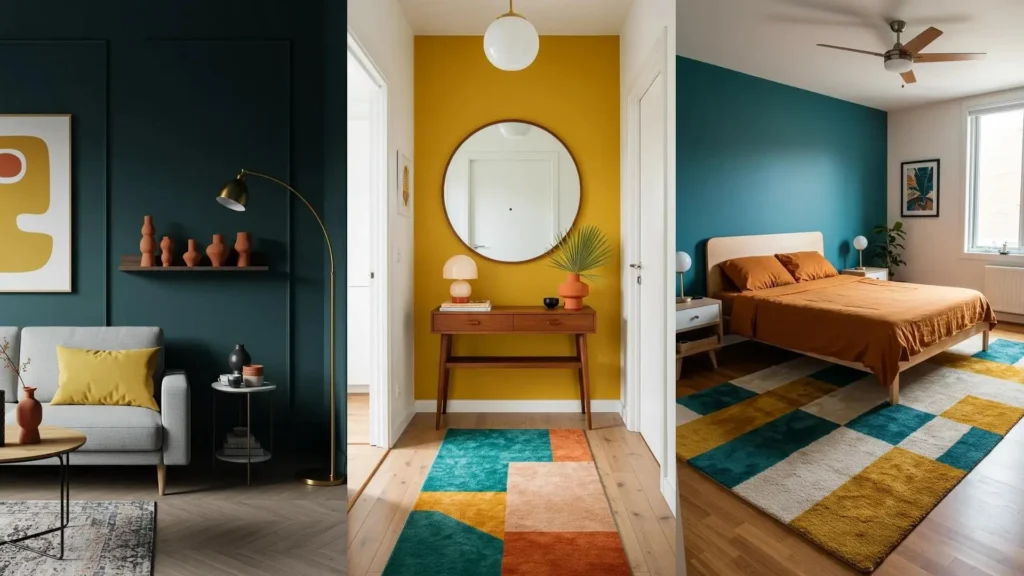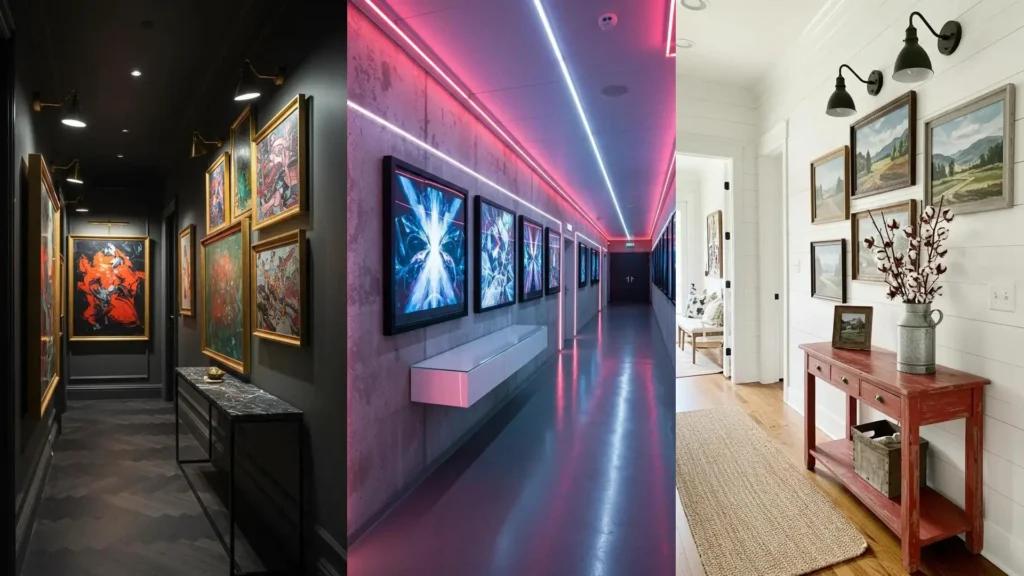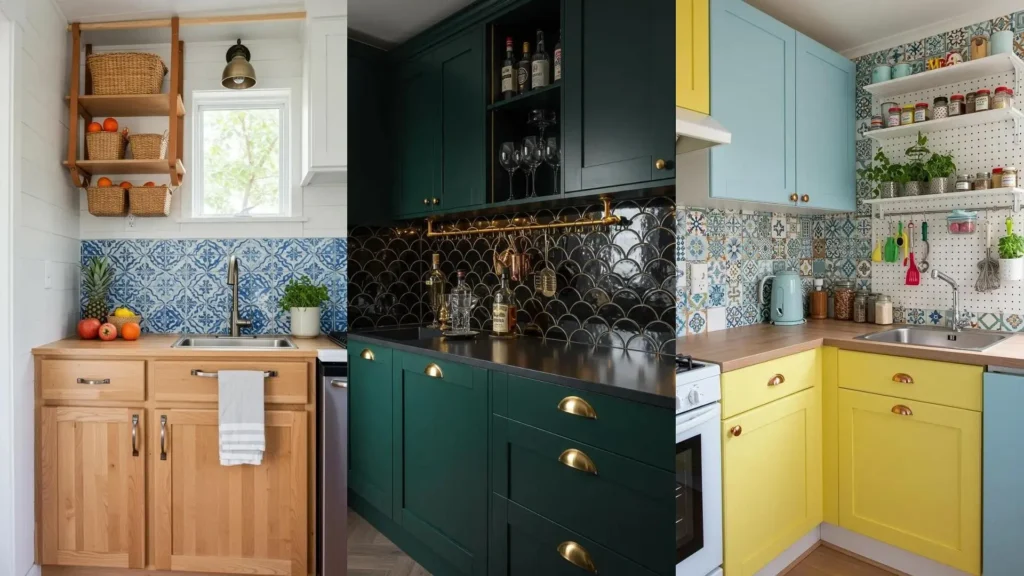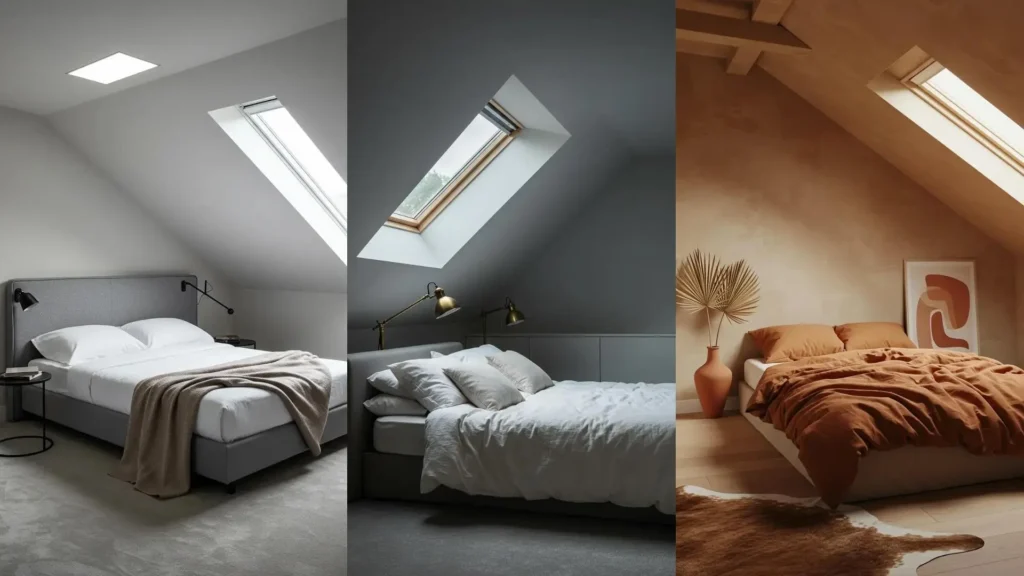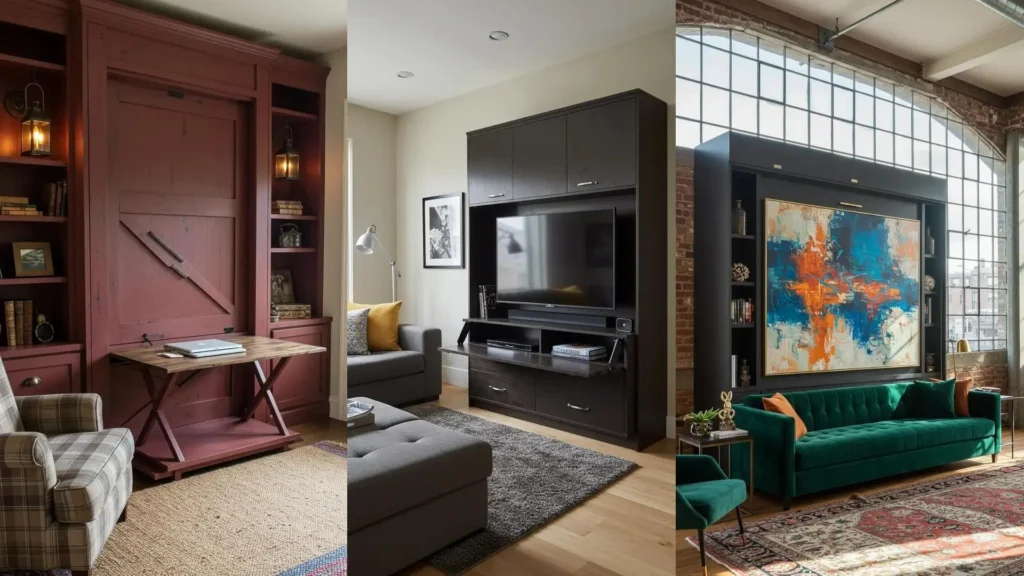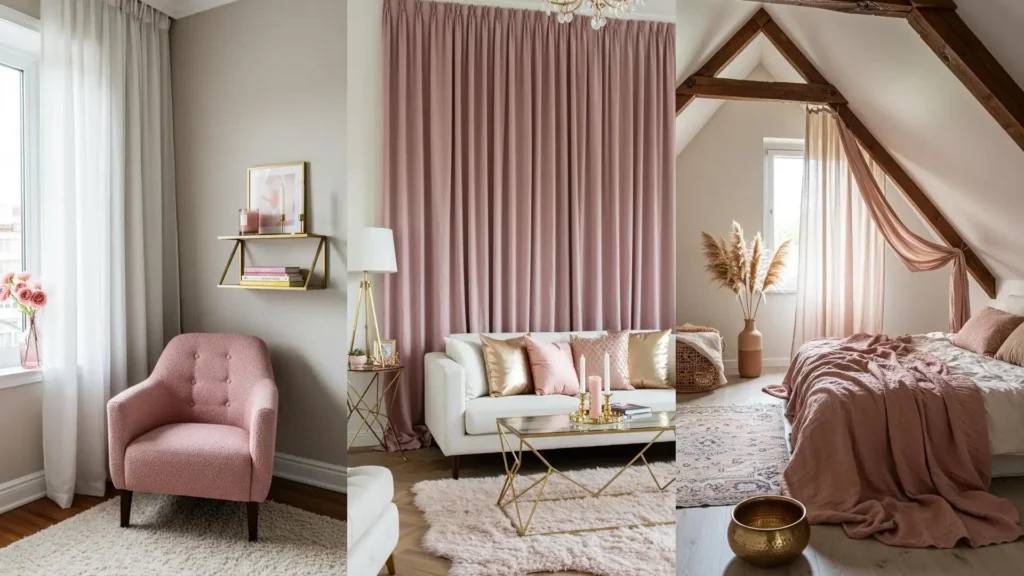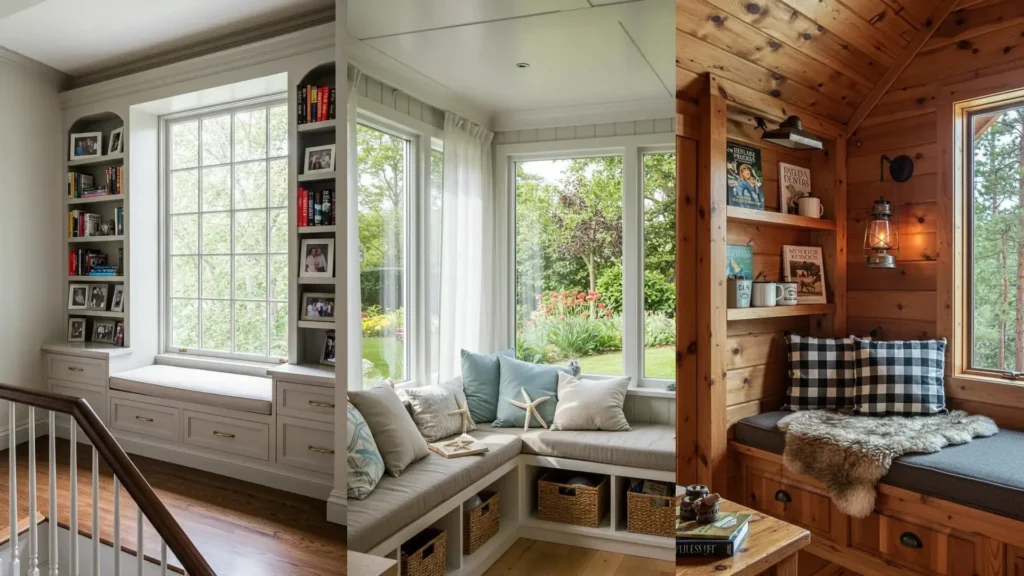Using bold color in a compact room can feel like a risk, but it’s one of the most effective ways to give a small space a strong, memorable personality.
The right combination of rich, earthy hues like mustard, teal, and terracotta can create depth, warmth, and a surprising sense of cohesion.
Forget the old rule that small rooms must be white. Instead, I’ll show you how to use this confident palette to make your space feel not just bigger, but more intentional, sophisticated, and entirely your own.
1. Anchor Your Room with Color and Pattern
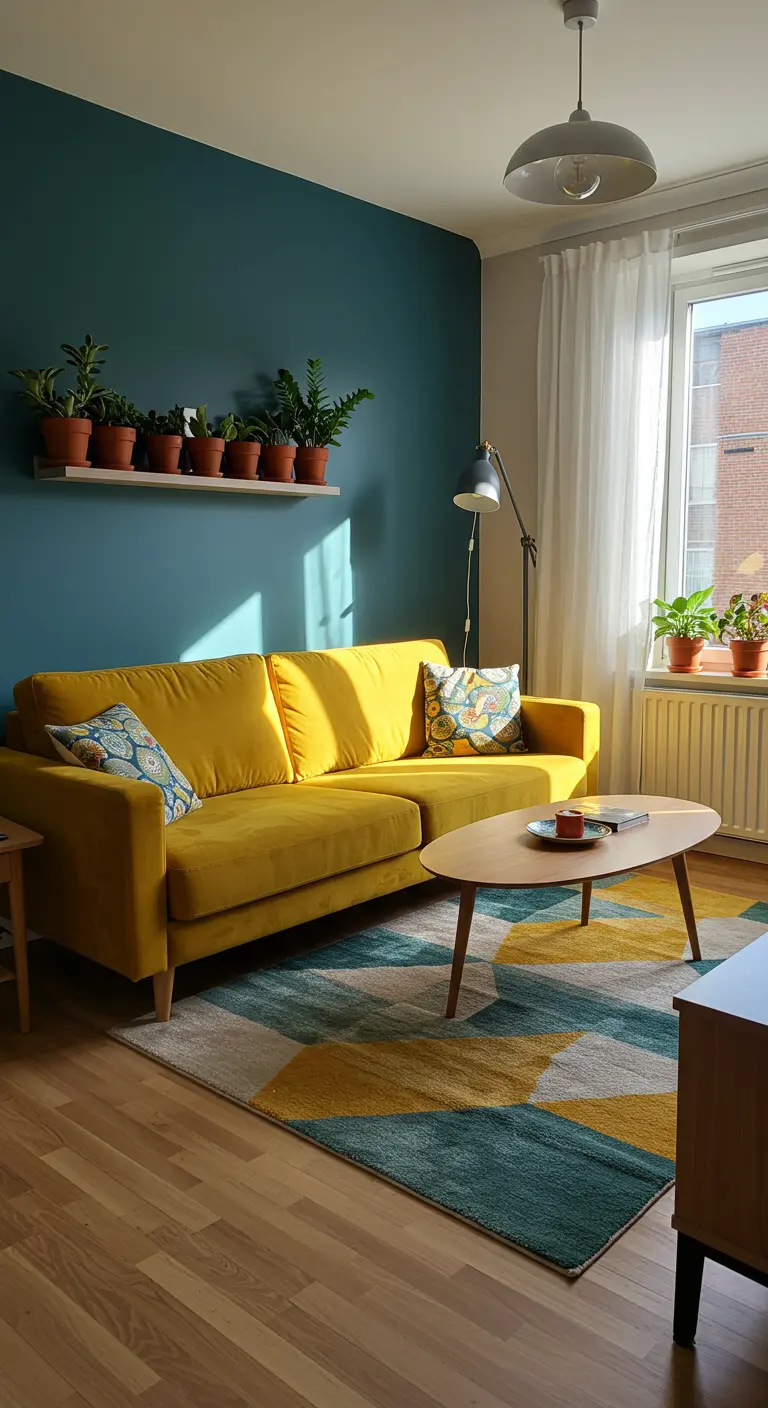
When using a bold color combination, establish a clear hierarchy to avoid visual chaos.
Here, a deep teal accent wall provides a rich, grounding backdrop, while the vibrant mustard sofa acts as the focal point.
A geometric rug that features both hues, along with a neutral tone, is the key to making the pairing feel intentional and harmonious.
This approach gives you a confident foundation for adding smaller accents, like the patterned cushions or the row of terracotta pots, which reinforce the color story.
For a simpler start, introduce the rug first to guide your choices for pillows and throws, allowing you to live with the palette before committing to paint.
2. Embrace the Immersion of a Single Hue
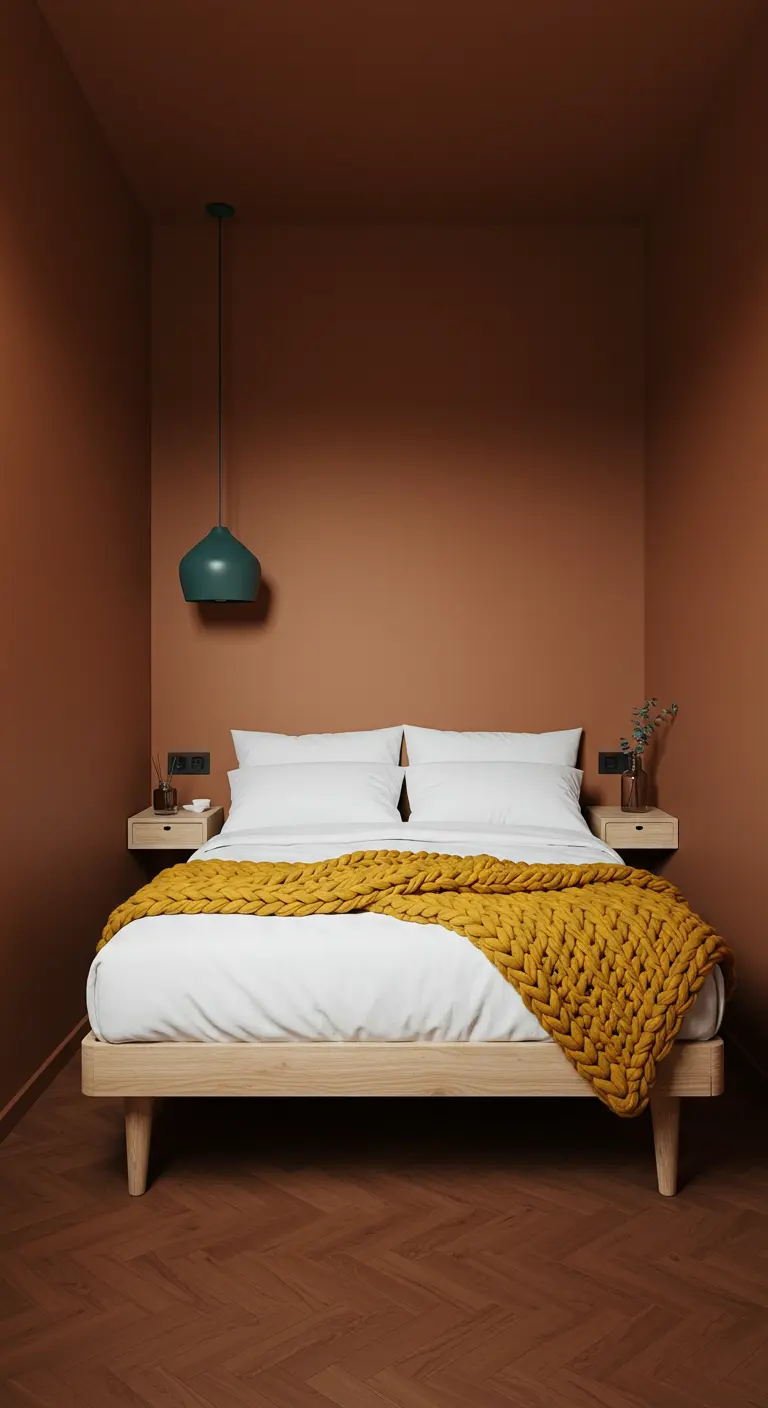
In a very compact bedroom, painting all walls a single, deep color like this terracotta can paradoxically make it feel larger.
This technique, known as color drenching, blurs the room’s edges and creates an enveloping, sanctuary-like calm.
Keep the bedding crisp and white to provide a clean visual break, preventing the color from feeling overwhelming.
Introduce your accent colors—mustard and teal—through singular, high-impact items like a chunky knit throw and a statement pendant light for a curated, moody yet modern feel.
3. Define a Work Nook with Graphic Wallpaper
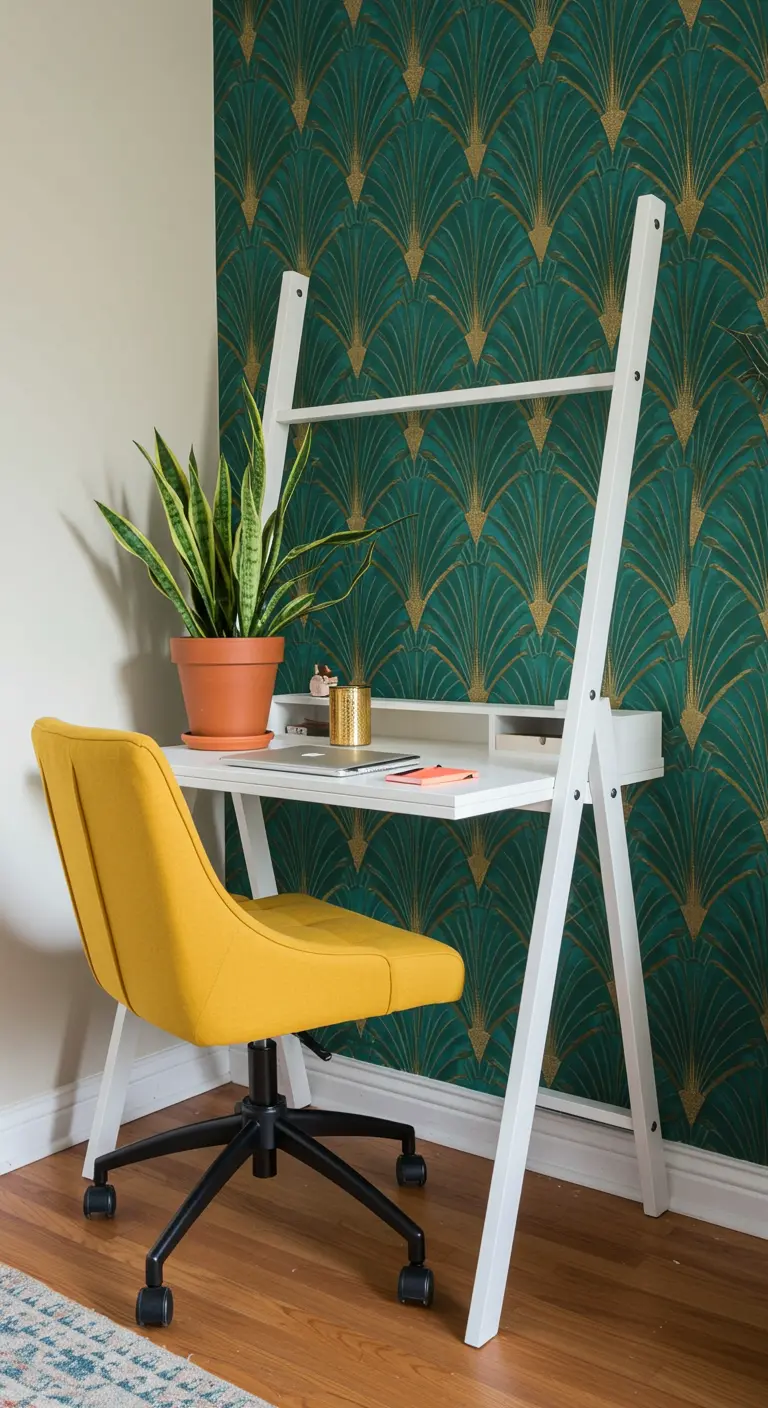
Carve out a functional workspace in any room by using a bold wallpaper to define the zone.
An Art Deco-inspired pattern in teal and gold, like this one, instantly signals a distinct area and adds a layer of sophisticated glamour.
Choose a desk with a minimal, open frame to prevent the corner from feeling heavy or cluttered.
A chair in a contrasting color—here, a rich mustard—completes the vignette, making it feel like a thoughtfully designed moment rather than an afterthought. This is one of the most effective accent wall ideas for small rooms.
4. Color-Block Your Kitchen with Confidence
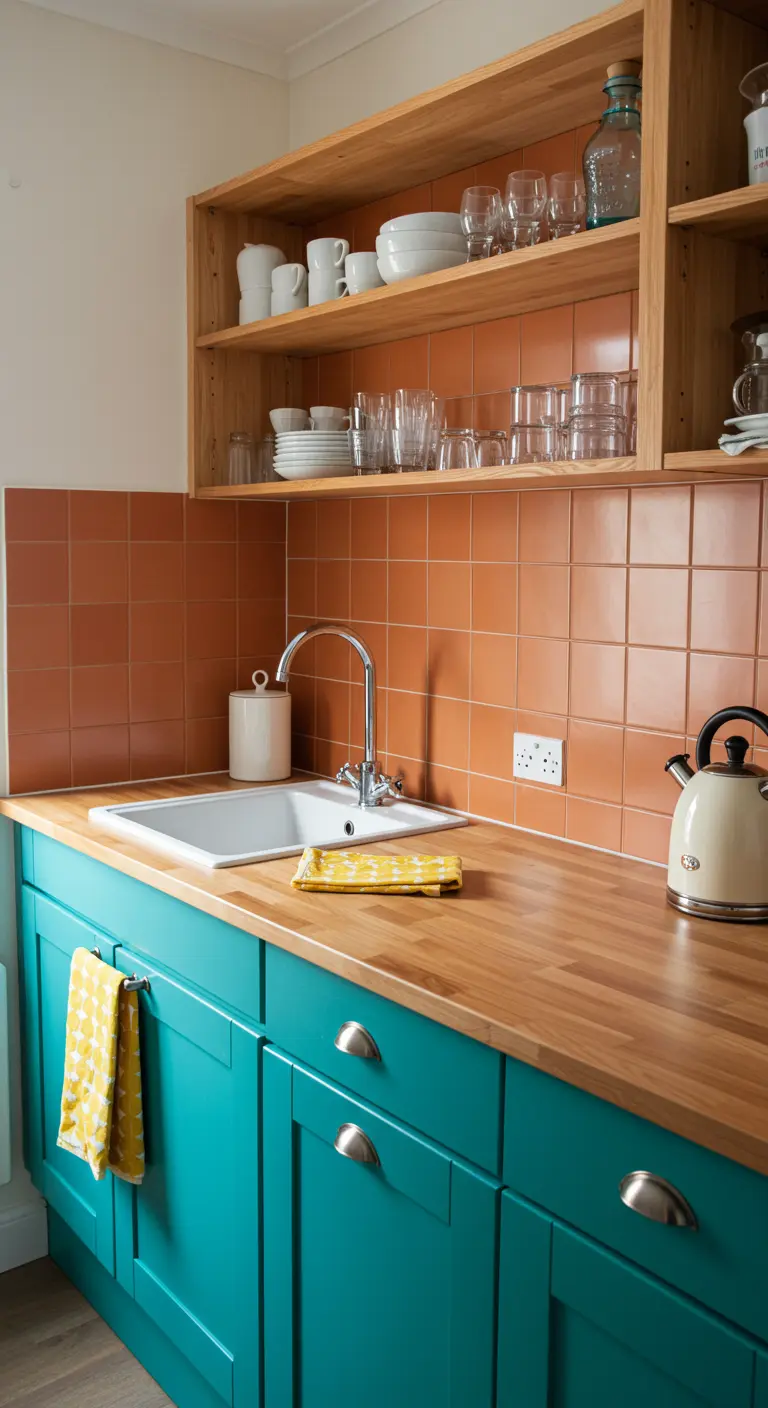
In the kitchen, think beyond paint and use permanent finishes to build your color story.
Pairing bold teal cabinetry with a warm terracotta tile backsplash creates a durable and deeply stylish foundation.
The key to balancing these strong colors is the introduction of a natural, warming element, like the butcher block countertop.
Finally, sprinkle in your third color—mustard—through easily changeable accessories like a dishtowel or a kettle for a playful, low-commitment final layer.
5. Let a Single Piece of Art Set the Tone
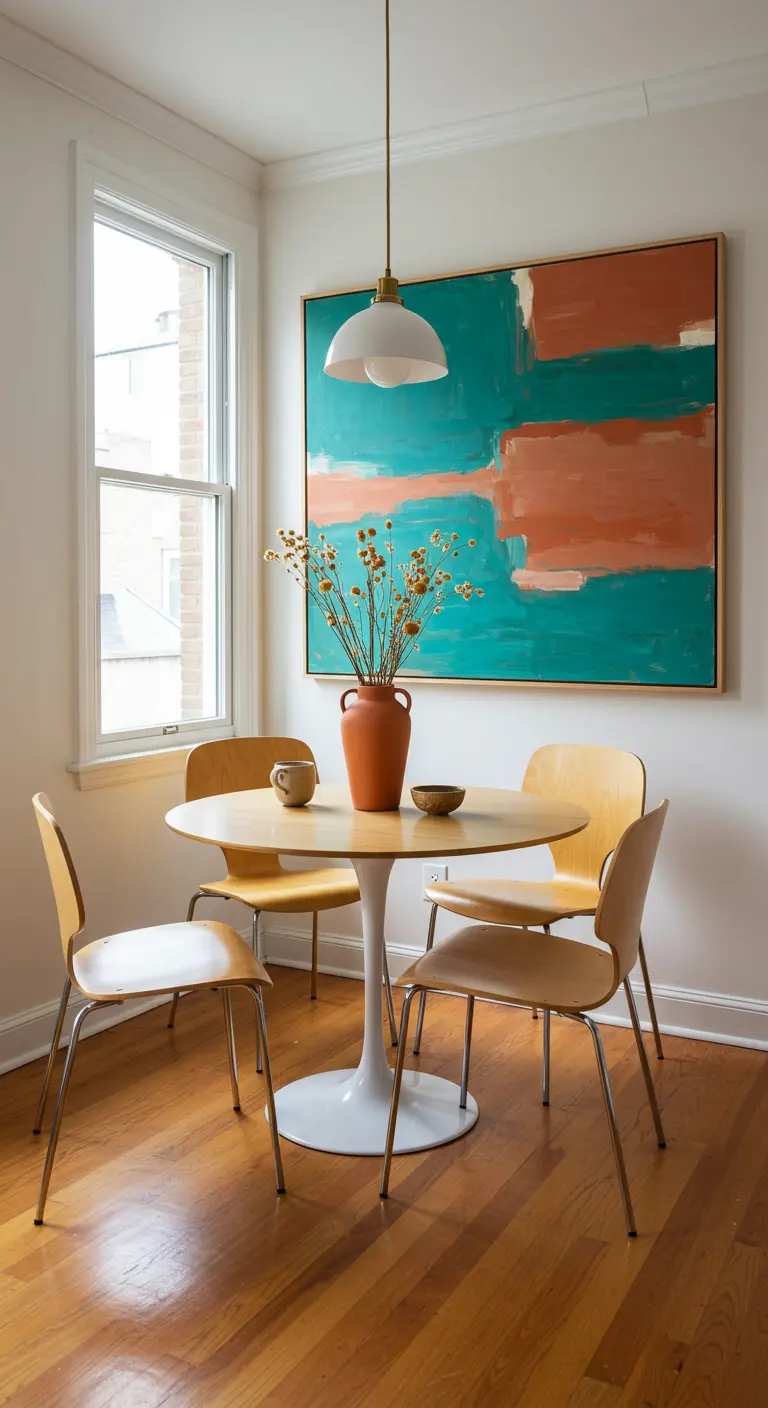
If you’re hesitant to commit to painting walls or buying new furniture, let a single piece of oversized art lead your design.
This large, abstract canvas in teal and terracotta establishes the entire room’s palette, making all subsequent decisions simpler.
Pull colors directly from the art for smaller items, like the terracotta vase, to create a cohesive look.
The warm, honey-toned wood of the Mid-Century Modern chairs and the white tulip table provide a neutral stage that allows the artwork to remain the undisputed star.
6. Test the Palette with Textiles First
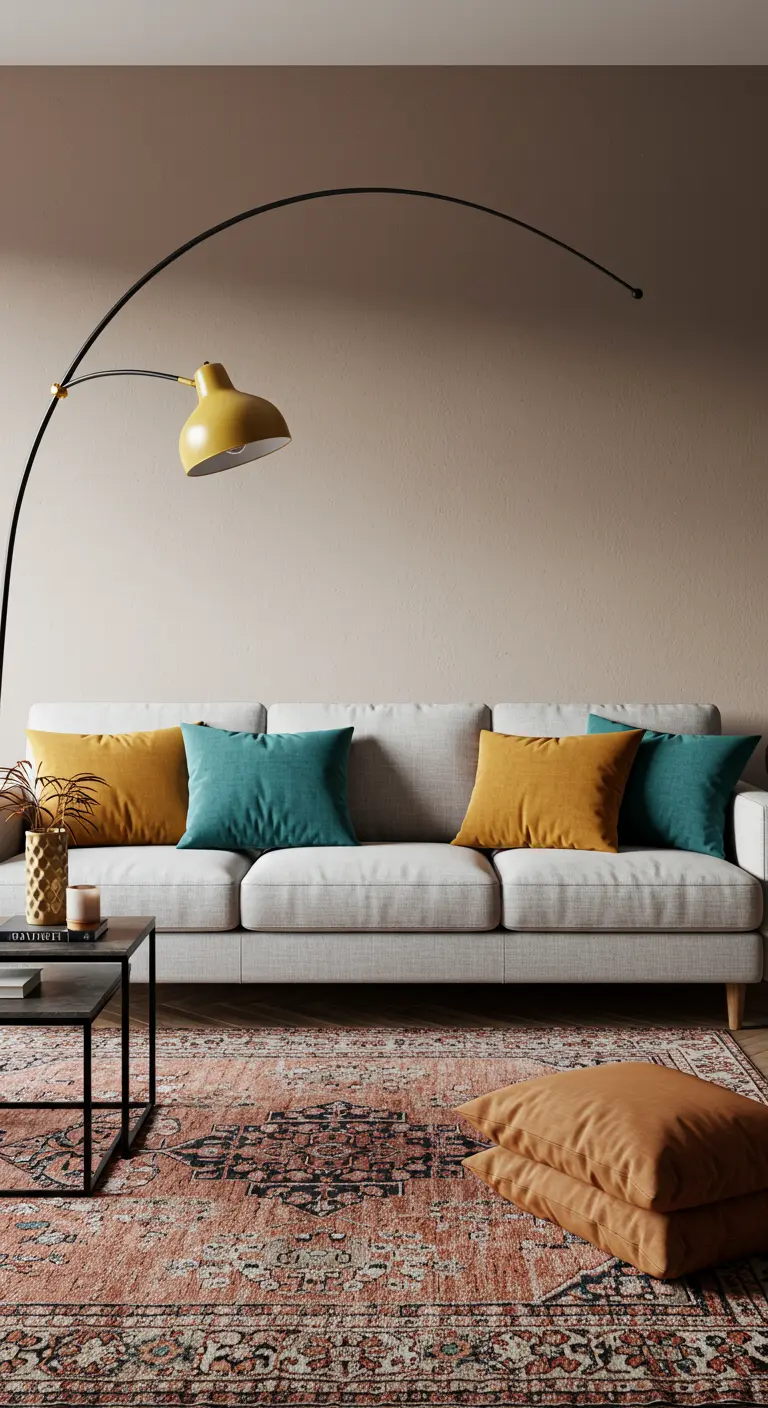
For a non-permanent way to explore this color trio, leave your walls and large furniture neutral.
Introduce mustard and teal through velvet or linen cushions on a simple gray or beige sofa.
Then, ground the space with a large rug that features a warm, earthy terracotta as its dominant color.
This layered approach allows you to control the intensity and is perfect for renters or anyone who enjoys changing their decor seasonally. You can create textured bohemian nooks with just a few key pieces.
7. Ground Bright Walls with Earthy Flooring
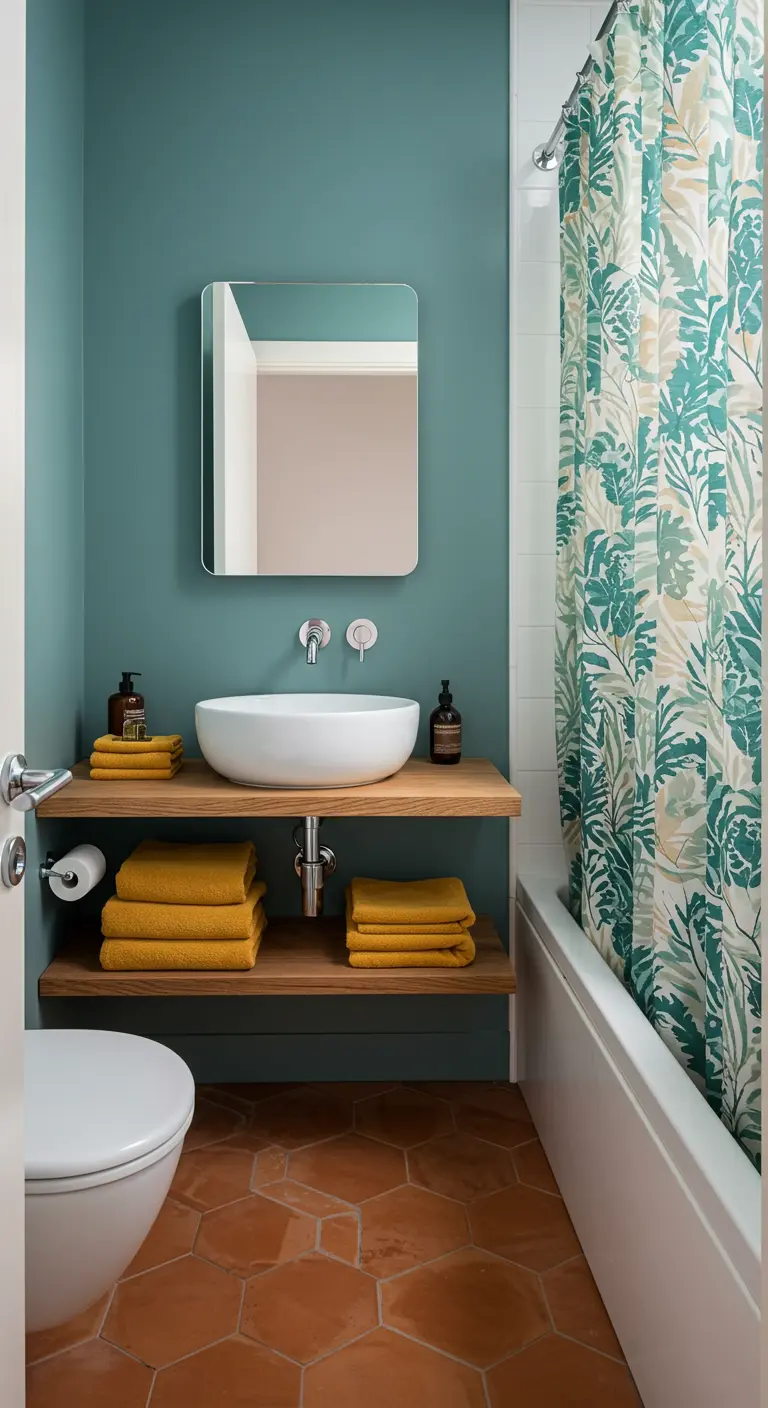
In a small bathroom, you can use a confident wall color like teal without it feeling cold or stark.
The secret is to pair it with a flooring material that provides warmth and texture, like these hexagonal terracotta tiles.
The earthy red-brown tone of the floor visually anchors the space, allowing the teal to feel refreshing rather than overwhelming.
Complete the look by adding your third color, mustard, through soft, easily swappable textiles like hand towels and bath towels.
This strategy is central to many boho-tropical bathrooms and it works beautifully here.
8. Layer Terracotta for a Bohemian Retreat
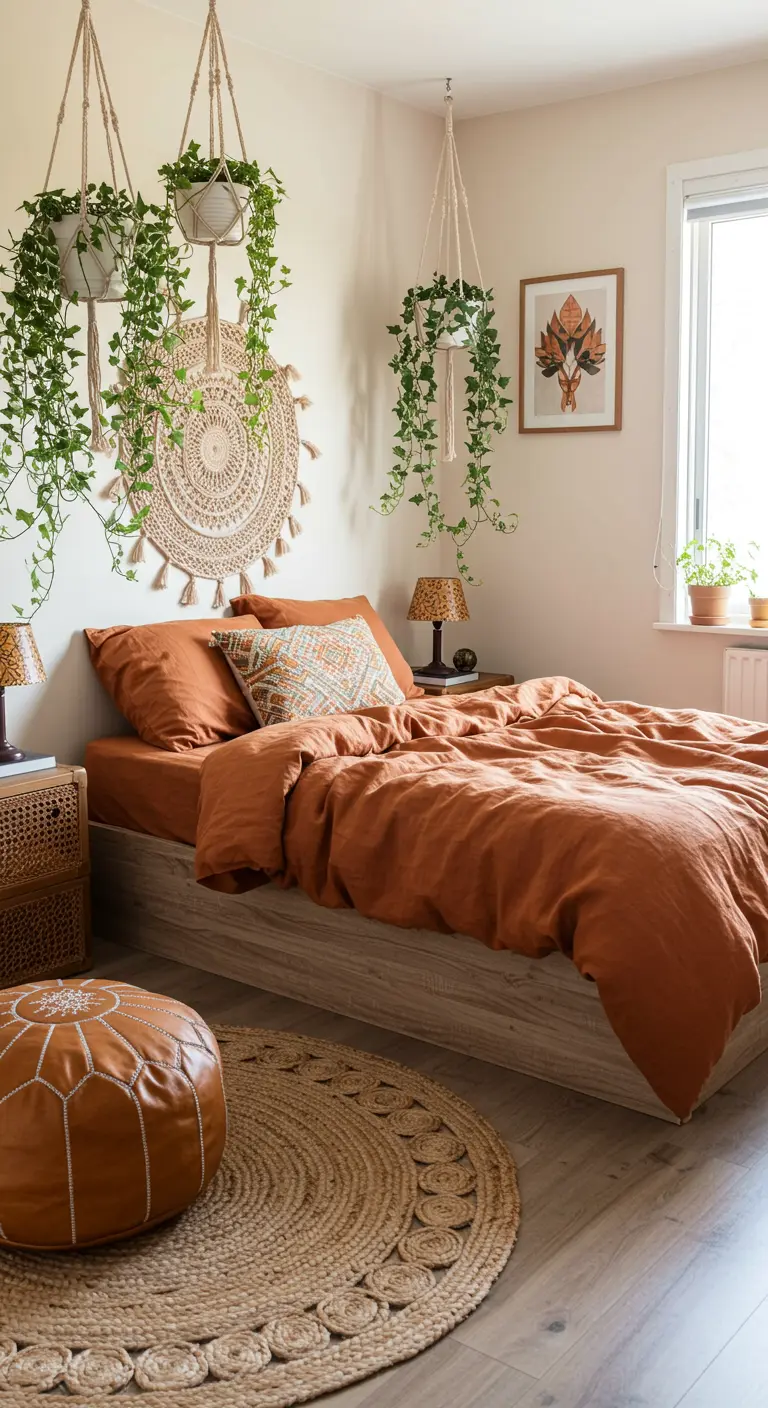
Create a warm, organic bedroom by making terracotta your primary color, expressed through soft, natural textiles like linen bedding.
Build on this earthy base by incorporating handmade textures and natural materials.
Here, a leather pouf, a jute rug, and macrame plant hangers all reinforce the relaxed, bohemian feel.
Just a hint of your other colors, seen in the patterned pillow, is enough to add dimension without disrupting the serene, monochrome mood.
9. Energize a Hallway with a Focal Point

Transform a narrow, functional hallway from a pass-through space into a true design moment.
Paint the far wall in a single, energizing color like mustard to draw the eye forward and create a focal point.
A large, round mirror is essential; it breaks up the flat wall of color, bounces light back into the space, and creates the illusion of depth.
Finally, a colorful runner that picks up on all three hues ties the entryway to the rest of your home’s palette. This is one of the smartest ways to define spaces in small apartments.
10. Divide Space with a Curtain of Color
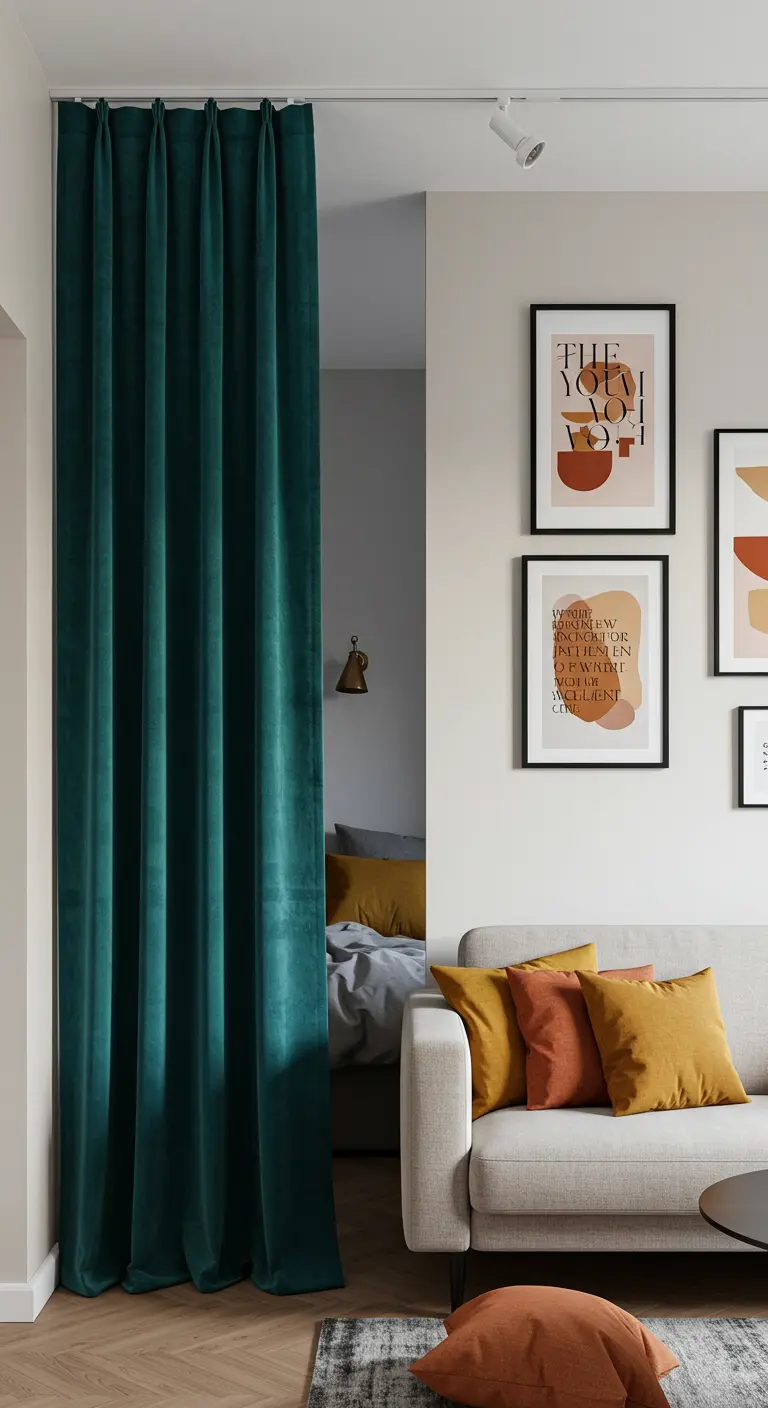
In a studio or a small one-bedroom apartment, a heavy velvet curtain is a more sophisticated and flexible alternative to a solid wall or screen.
Choosing a deep, luxurious teal adds a touch of drama and absorbs sound, creating a cozier, more private sleeping area.
Mount the curtain track directly to the ceiling to maximize the sense of height and ensure a clean, seamless look when closed.
This technique is a cornerstone of many smart one-bedroom apartment layouts because it offers privacy without sacrificing light or flow.
11. Create a Vignette with Color and Texture
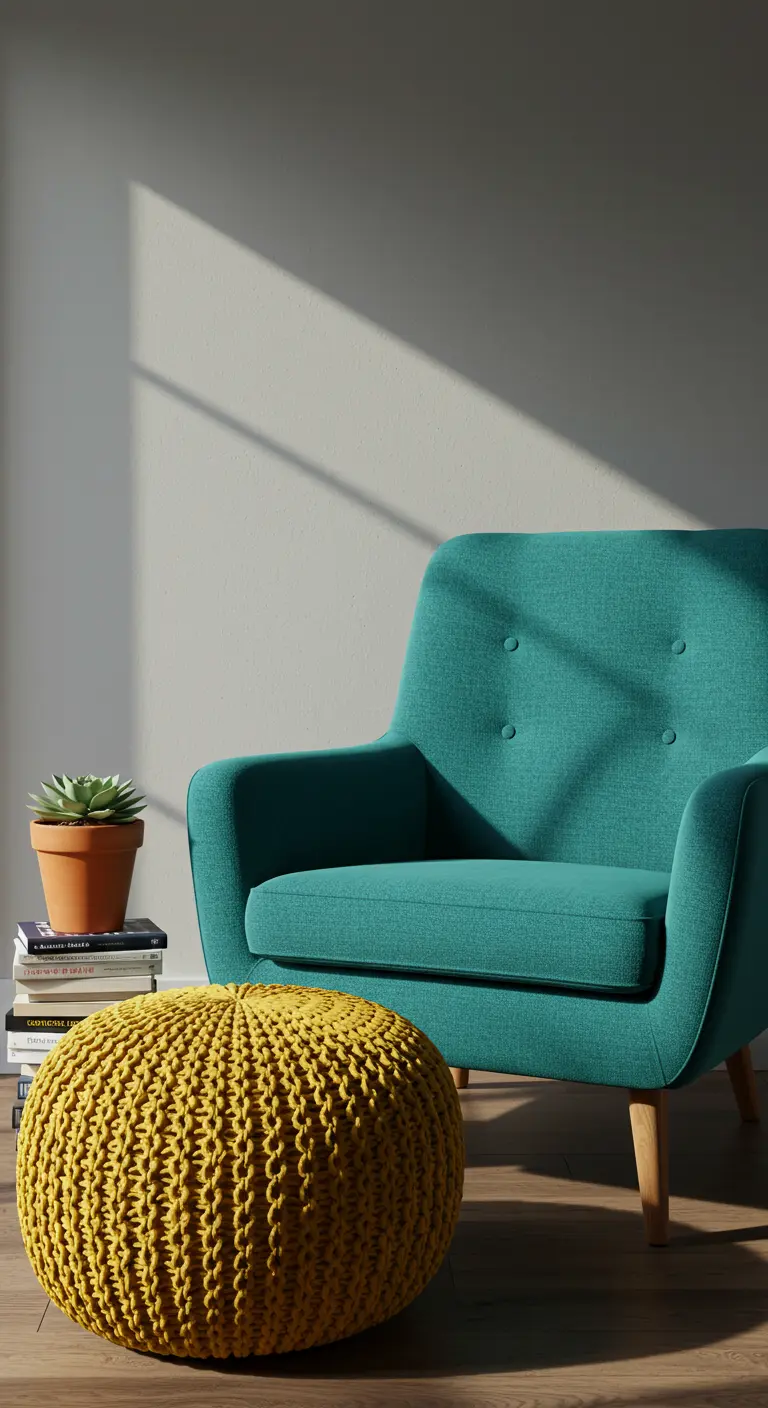
You don’t need to paint a whole room to make an impact; instead, create a small, intentional vignette.
Pair a structured, tufted armchair in a saturated teal with a soft, pliable knitted pouf in mustard.
The contrast in both color and texture is what makes this simple combination so visually compelling.
Place them in a sunlit corner with a stack of books and a small plant, and you’ve instantly created an inviting reading spot.
12. Extend Your Color Palette to the Balcony
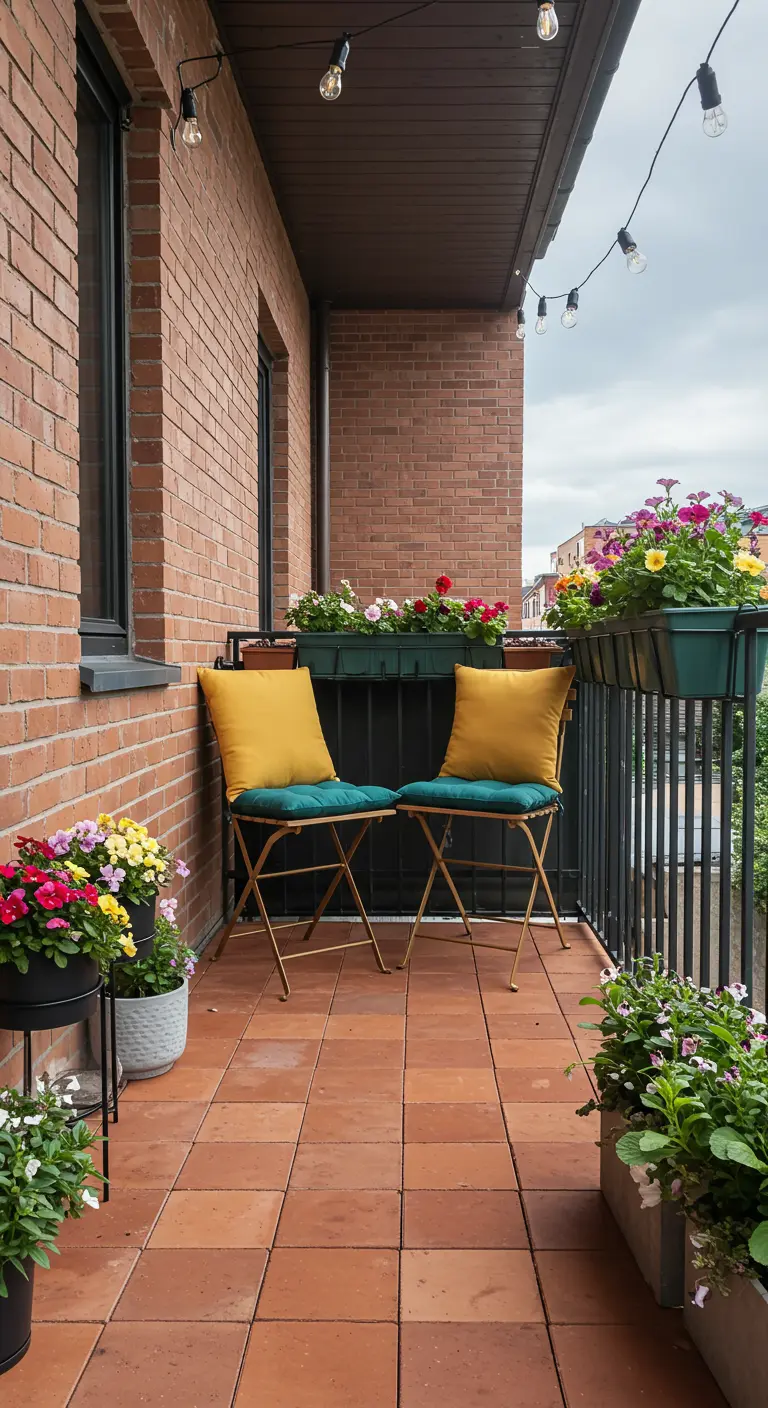
Treat your balcony as an extension of your interior living space by carrying your color scheme outdoors.
Here, terracotta floor tiles provide a warm, durable base that connects to the brick facade.
Simple folding bistro chairs become statement pieces when their seats are teal and their cushions are a bright, welcoming mustard.
This approach makes even the smallest outdoor space feel curated and connected to your home. Explore more colorful tile mosaic balconies for further inspiration.
13. Design a Cozy, Color-Saturated Nook
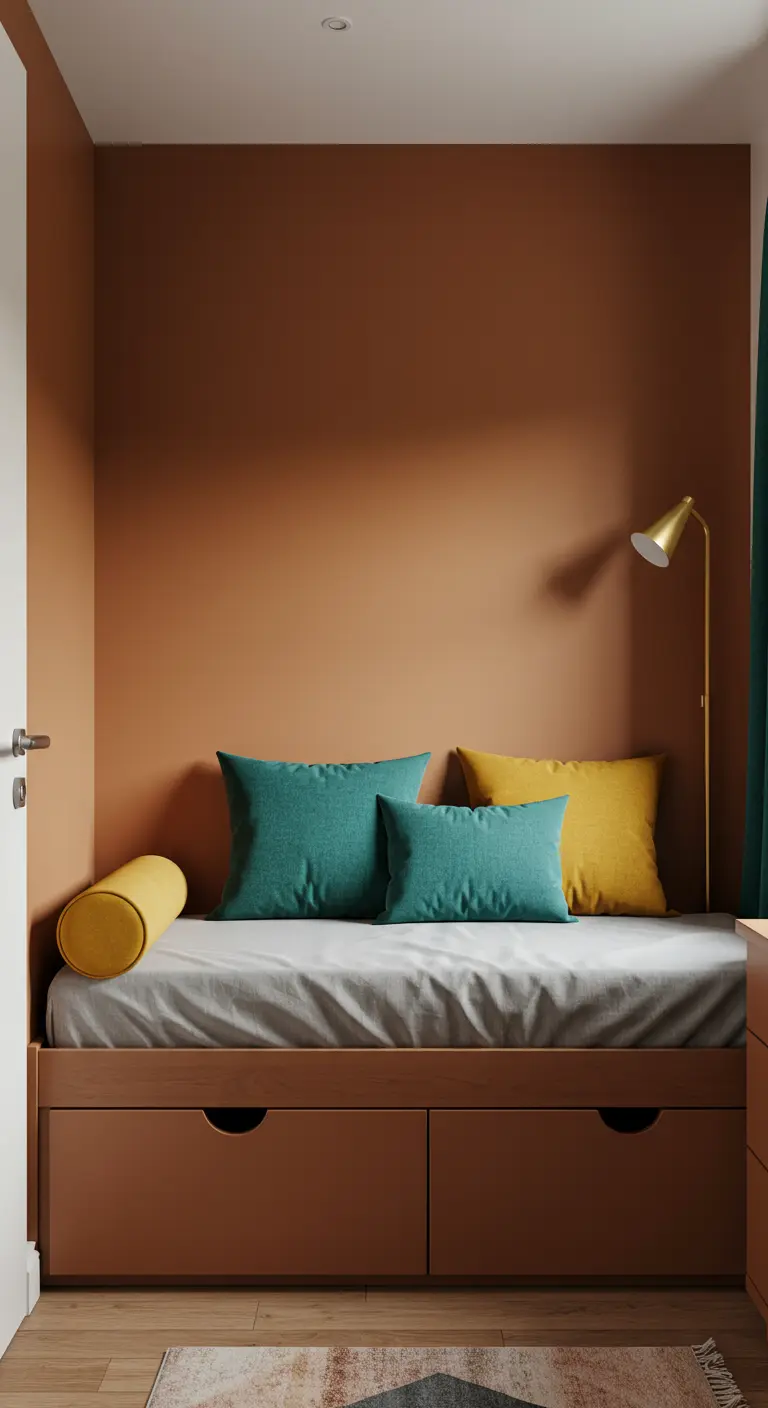
Make a small guest bed or daybed feel purposeful by transforming it into a cozy, built-in nook.
Painting the surrounding walls in a warm, enveloping terracotta creates a den-like feel that’s perfect for sleeping or lounging.
Choose pillows in your accent colors—teal and mustard—to add pops of energy and visual interest.
This setup works especially well in stylish multipurpose rooms, where a daybed can serve as both seating and a guest space.
14. Add Sophistication with Tonal Moulding

Elevate a simple painted wall by adding subtle architectural detail.
Apply simple, flat picture frame moulding to the wall before you paint, then coat everything—wall and moulding—in the same deep teal color.
This technique creates soft shadows and a sense of depth, making the room feel more structured and expensive without closing it in.
It’s a hallmark of quiet luxury interiors, where texture and tone do more work than pattern.
A simple shelf of terracotta pottery provides a perfect, warm contrast.
15. Define a Nook with a Painted Arch
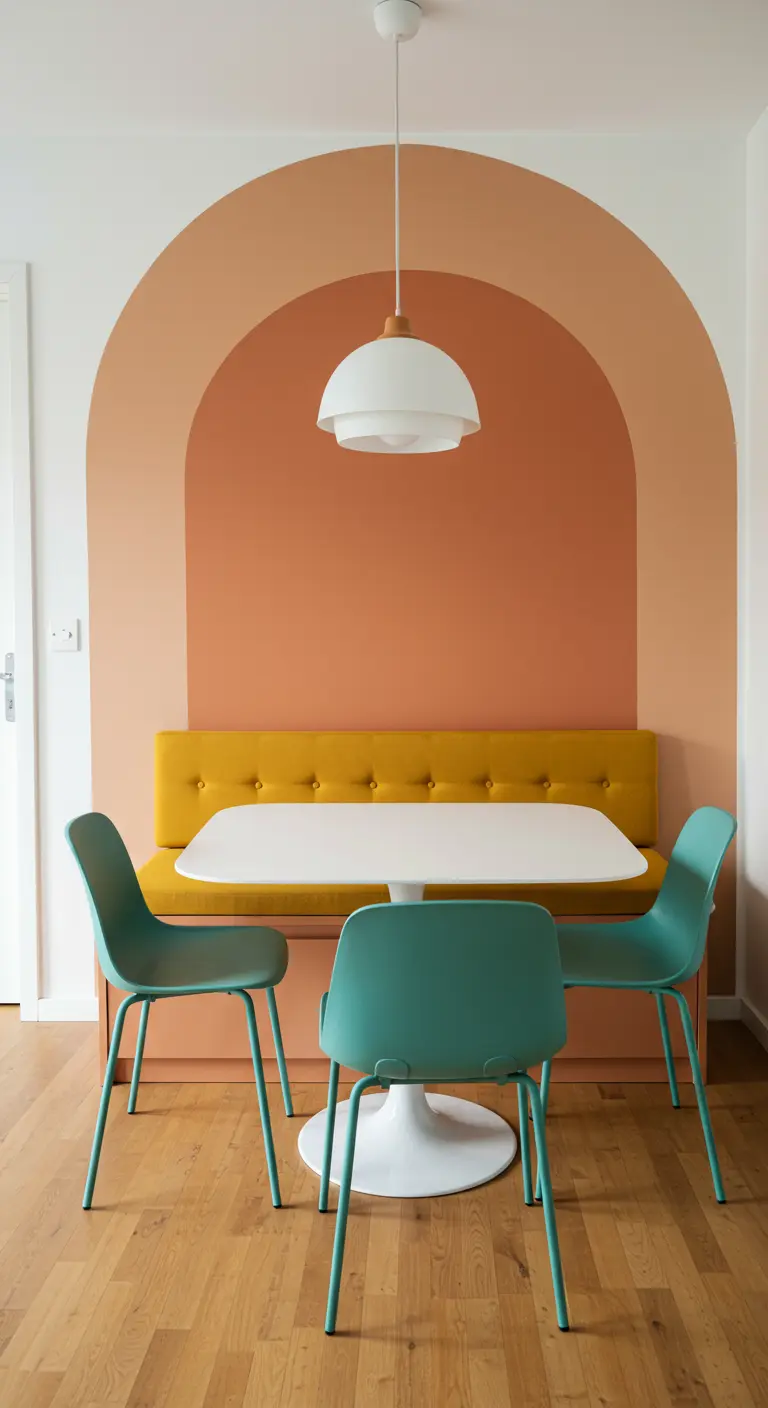
Visually separate a dining area from a larger room without building walls by painting a bold arch.
A gradient effect, moving from a lighter to a deeper terracotta, adds an artistic, bespoke quality that feels incredibly high-end.
A built-in banquette in a contrasting mustard color anchors the space, while modern teal chairs complete the palette.
This is a defining feature in many eclectic, colorful spaces and is surprisingly simple to achieve with painter’s tape and a few sample pots.
16. Look Up: The Impact of a Colored Ceiling

In a kitchen with neutral cabinets and walls, the ceiling offers a fantastic opportunity for a dose of unexpected color.
Painting it a deep teal draws the eye upward, creating a sense of height and drama.
Anchor this bold choice by painting the kitchen island in a coordinating mustard yellow.
The terracotta stools and copper hardware tie the warm and cool tones together, proving that even compact urban kitchens can handle a daring color statement.
17. Layer Your Palette Through Bed Linens
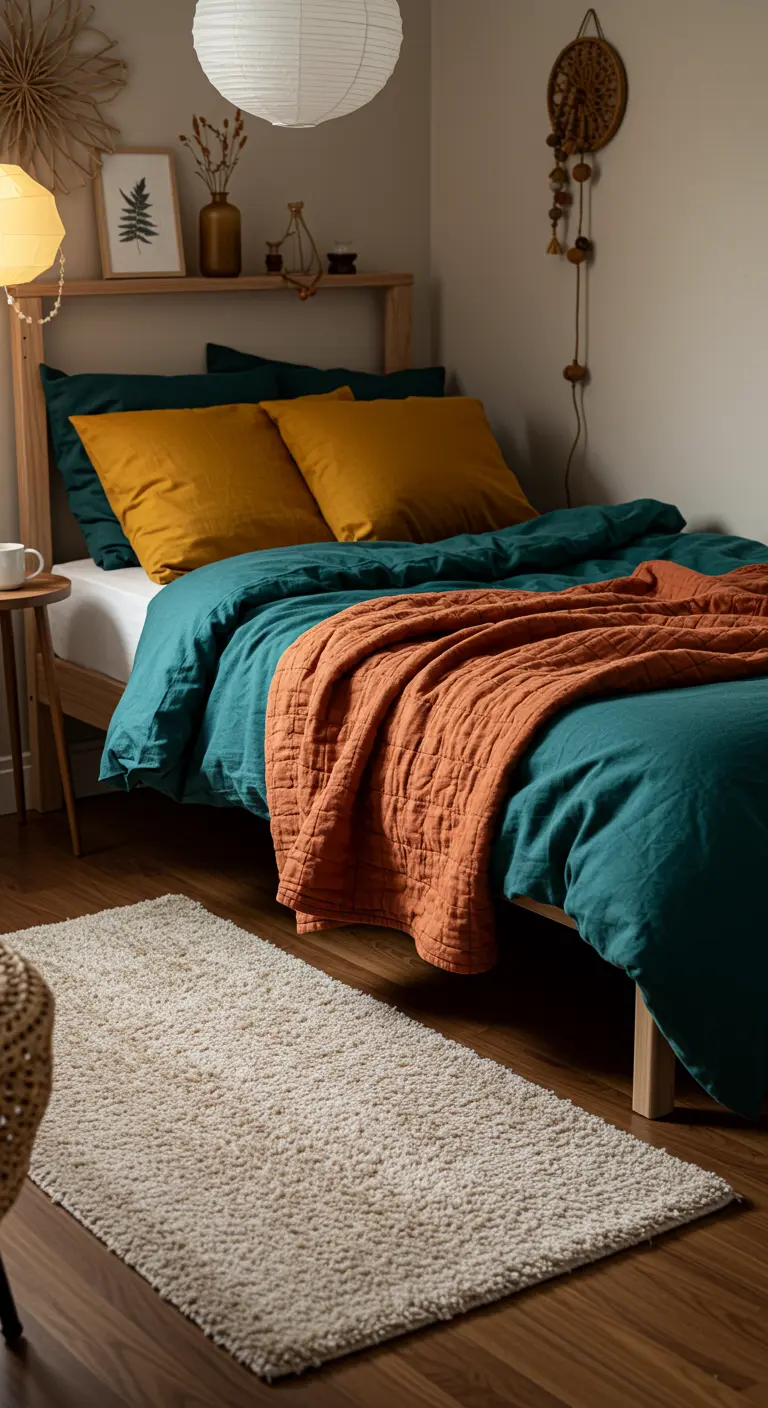
The bed is the largest piece of furniture in most bedrooms, making it the perfect canvas for color experimentation.
Layering your bedding allows you to use all three colors without any single one dominating.
Start with a deep teal duvet cover as your base, add warmth with mustard pillowcases, and finish with a textured terracotta throw blanket folded at the end.
Choosing natural fabrics like organic cotton or linen, as seen in many eco-friendly romantic bedrooms, adds softness and breathability.
18. Turn Storage into a Statement Feature
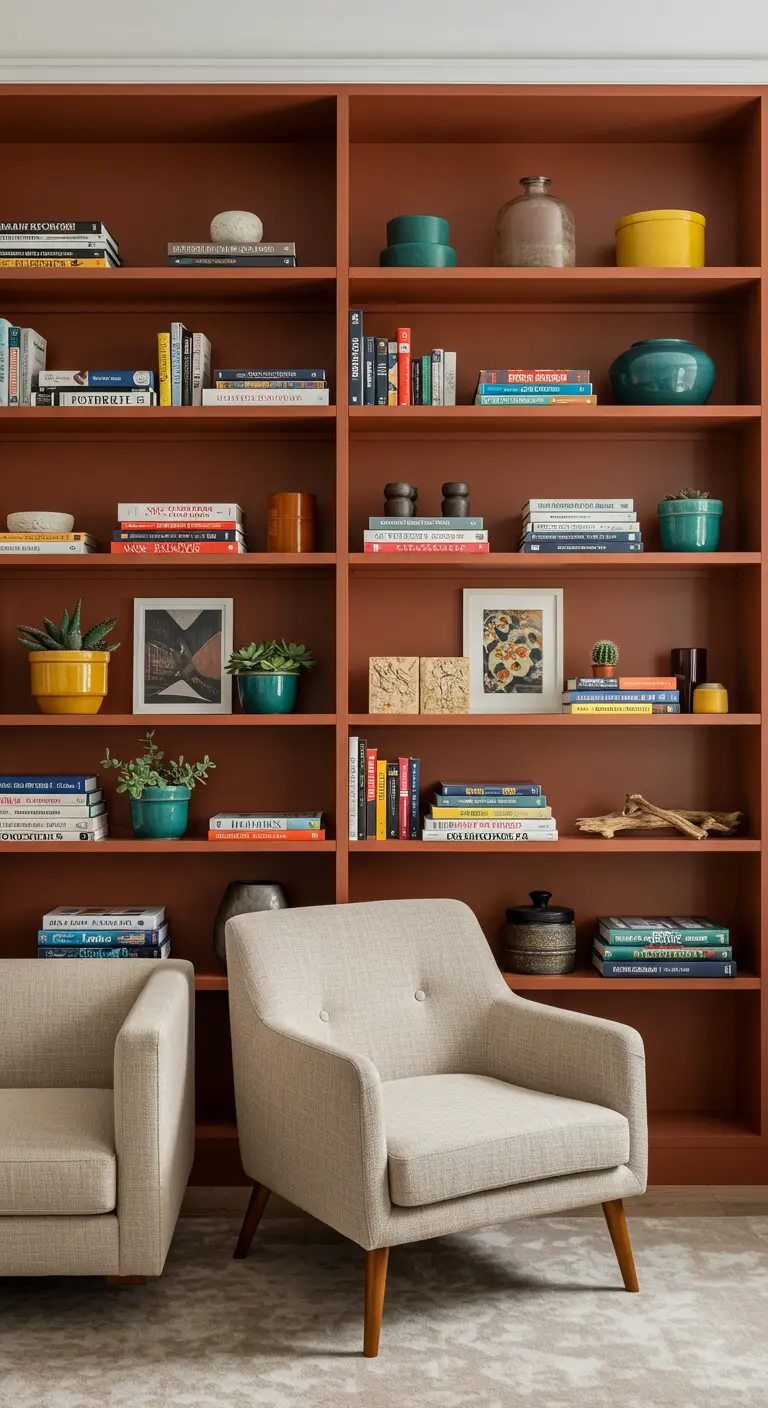
Instead of trying to make bookshelves disappear, turn them into the room’s main architectural feature.
Painting a floor-to-ceiling shelving unit in a rich, earthy terracotta creates a powerful, cohesive backdrop that feels both warm and intellectual.
This approach, often seen in Dark Academia interiors, makes the shelving unit feel intentional and integrated.
Style the shelves with books and decorative objects in your accent colors—teal and mustard—to break up the color and add points of interest.
19. Modernize Wainscoting with Color Blocking
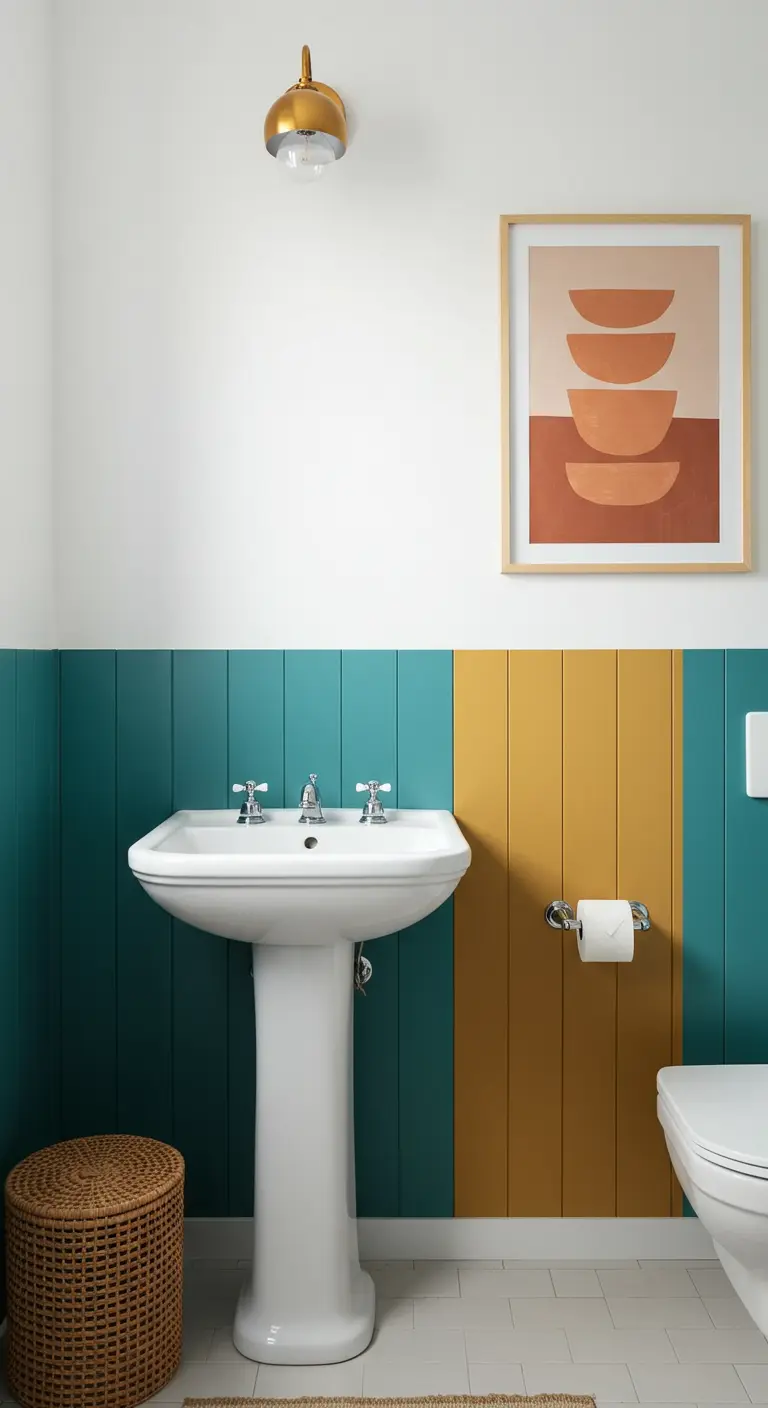
Give traditional wainscoting or wall paneling a contemporary update with a color-blocked design.
Here, vertical panels are painted in a dominant teal, with an unexpected block of mustard creating an asymmetrical focal point behind the sink.
This technique adds visual interest and a playful, graphic quality to a small powder room without overwhelming it.
It’s a clever paint-based alternative to using graphic tile, and you can tie it all together with a piece of art that features a hint of terracotta.
20. Create a Cohesive Gallery Wall with Color

A large, blank wall can be intimidating, but a triptych—a set of three art panels—is a simple solution for creating high-impact art.
Instead of searching for one perfect piece, create your own by painting three canvases in solid or subtly blended fields of mustard, teal, and terracotta.
Hanging them together with minimal spacing creates a single, cohesive statement that feels modern and intentional, offering a different approach to more eclectic gallery wall styles.
21. Elongate a Galley Kitchen with a Runner
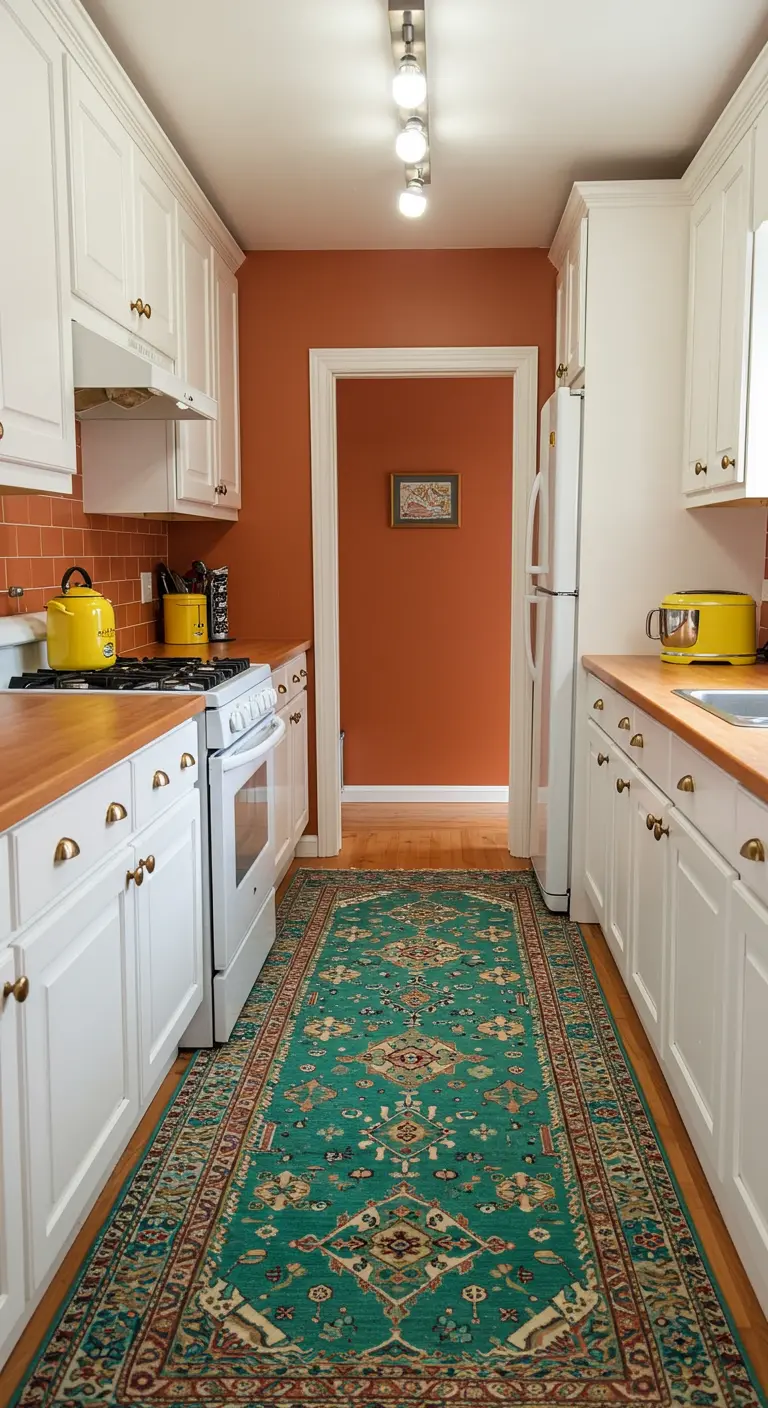
In a narrow galley kitchen, a colorful runner serves a critical design function.
Its long, linear shape draws the eye down the length of the room, creating an illusion of greater depth.
Choosing a vibrant teal rug provides a cool contrast to the warm terracotta walls and butcher block countertops.
Little pops of mustard in the kettle and canisters complete the palette, proving that clever layout tweaks can transform a challenging space.
22. Unify Your Bedroom with a Statement Rug

In a bedroom with a bold accent wall and coordinating bedding, a rug is the element that ties everything together.
Here, a teal wall and terracotta bedding could feel disconnected without the large, color-blocked rug underneath.
The rug’s pattern explicitly combines the room’s main colors—teal, terracotta, and mustard—with a calming neutral white, creating a harmonious and unified scheme.
It grounds the furniture and makes the entire design feel complete and considered.
23. Balance Bold Color with Natural Textures
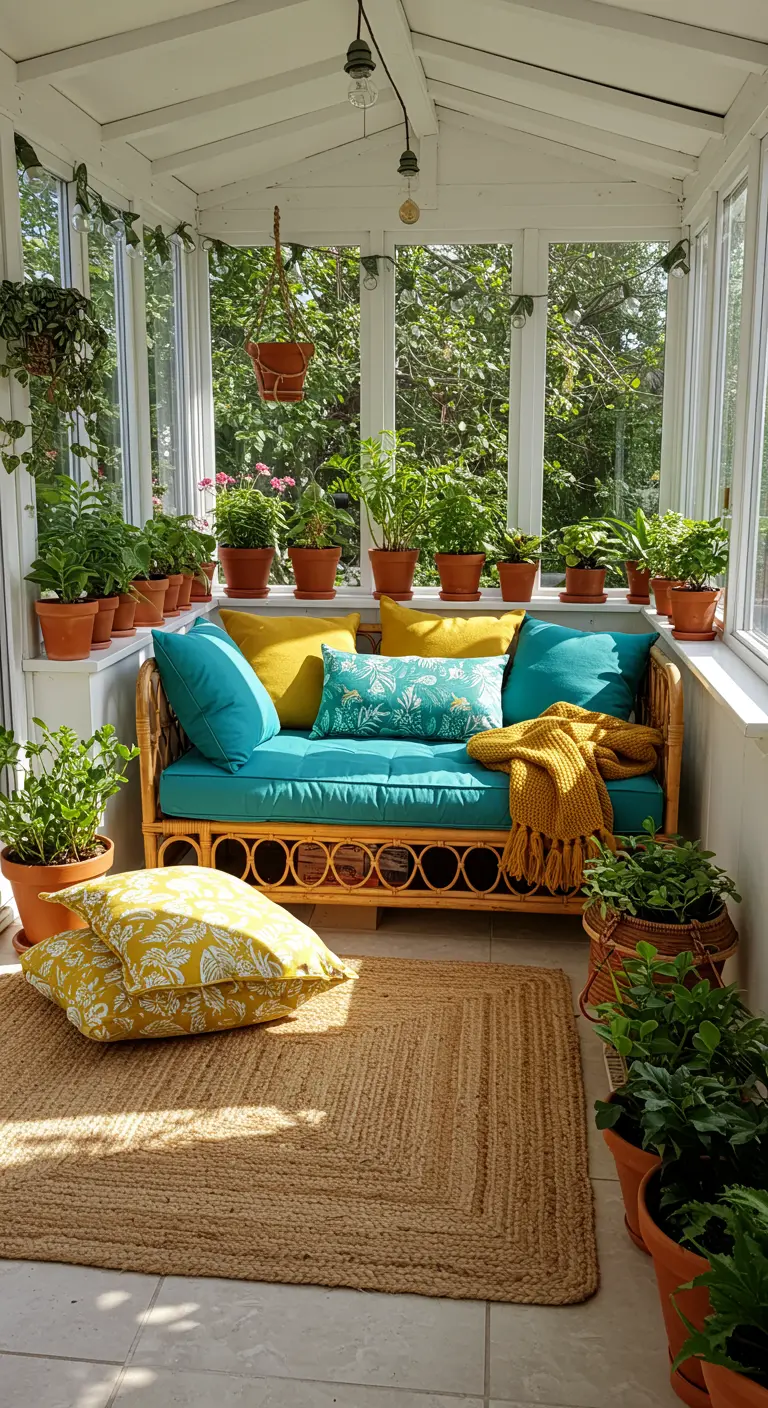
When your color palette is this vibrant, you need to balance it with plenty of natural texture to keep it from feeling synthetic.
In this sunroom, the bright teal and mustard pillows are grounded by the organic feel of the rattan sofa frame, the woven jute rug, and the terracotta pots.
This space is a perfect example of an urban jungle living room, where the abundance of greenery further softens the bold hues and enhances the connection to nature.
24. Repeat Colors to Unify an Open-Plan Space
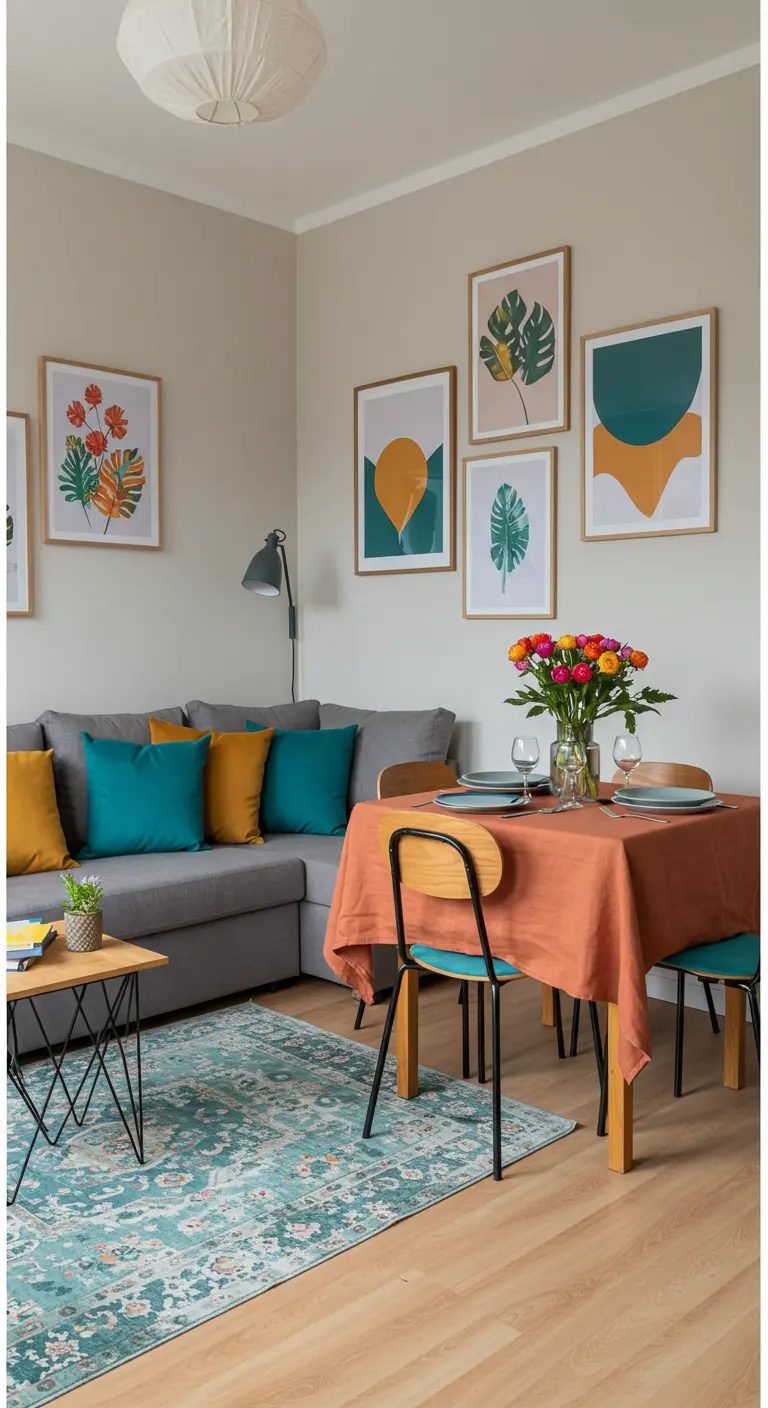
In a compact, open-plan apartment, repetition is your most powerful tool for creating a sense of cohesion.
Define your color palette—mustard, teal, terracotta—and then sprinkle it across the different functional zones.
Here, a terracotta tablecloth defines the dining area, while teal and mustard pillows mark the lounge space.
A gallery wall featuring art with all three colors acts as the final unifying element, making two distinct areas feel like one harmonious home. This strategy is key when you need to combine workspaces and living areas.
25. Layer Luxe Textures for a Hotel Feel
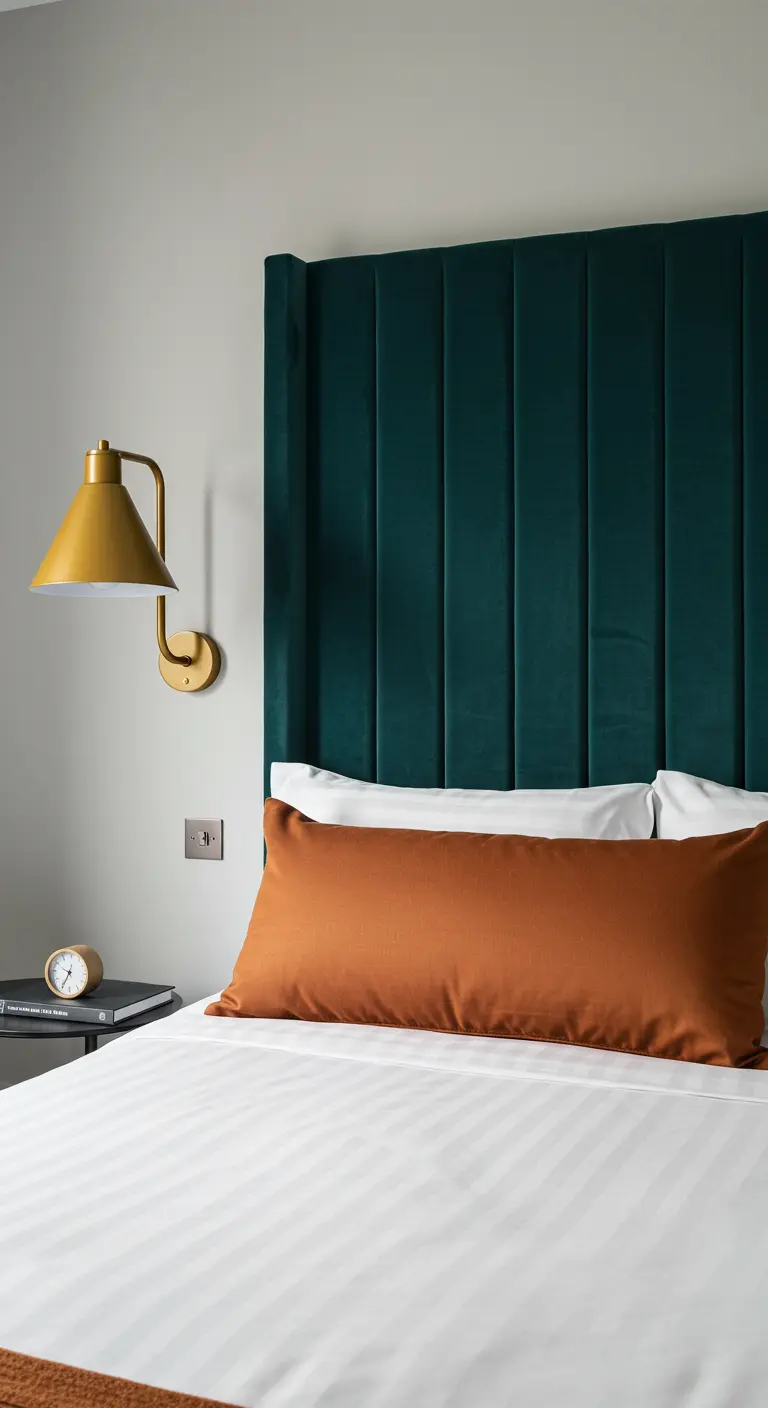
To give your bedroom a boutique hotel feel, focus on the interplay of luxurious textures.
A floor-to-ceiling headboard in deep teal velvet provides a dramatic and acoustically soft backdrop.
Contrast this with the smooth, cool feel of a terracotta-hued silk or satin lumbar pillow.
The final touch is a mustard yellow wall sconce with a matte brass finish, adding a warm glow. It’s these luxe, velvet-draped designs that elevate a room from simple to truly special.
